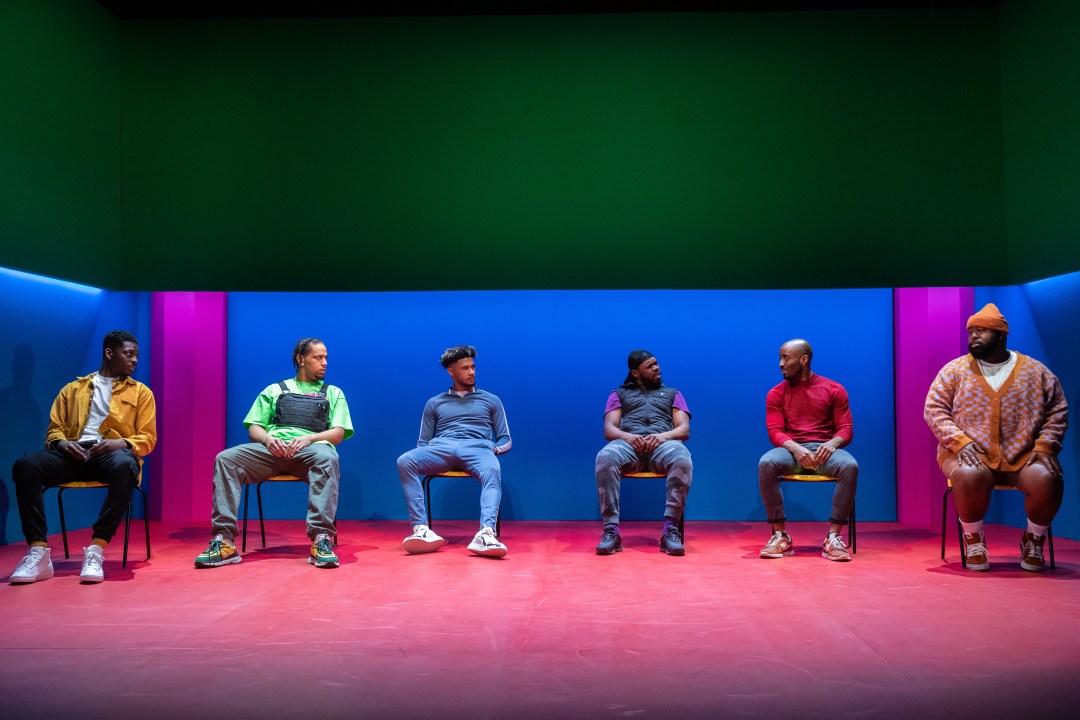The psychiatrist and political philosopher Franz Fanon published the book Black Skin, White Masks in 1952. With chapter titles such as ‘The Black Man and Language’, ‘The Black Man and The White Woman’, and ‘The Black Man and Psychopathology’, the book remains a rigorous and unflinching dissection of the psychology of race from a black perspective. The play For Black Boys Who Have Considered Suicide When The Hue Gets Too Heavy takes inspiration from Ntozake Shange’s 1976 theatre piece, For Colored Girls Who Have Considered Suicide/When the Rainbow Is Enuf. Fanon is however, an equally important reference when thinking about the staging of this work at the Royal Court.
Written and directed by Ryan Calais Cameron the play focuses on the stories of six young black men who have come together for group therapy. The performance presents sets of experiences that are often harrowing but also includes moments of joy and rapture. The opening scene uses dance and stark lighting to stunning visual effect. The sequence ends with the group of men holding up the actor Nnabiko Ejimofor in an entwined formation that evokes a contemporary Pietà. This powerful start sets the tone for the fast paced and dynamic narrative to unfold from.
The play speaks directly to the multifaceted and complex psychology of being a young black man in 21st-century Britain. Starting in early childhood and moving through to adulthood, the various vignettes relayed show how our society creates victimisation and estrangement for some, but not others. Despite accounts of racism, bullying and police harassment, there is also humour and optimism. The energy bounces off the stage and ranges from emotionally dark to celebratory. Horrific and beautiful. The bright and garish, acid pop colour schemes of the set and lighting, work as a great device to contrast the testimonies being given.
Audience interaction is a huge part in this play’s success. The mood in the room goes from raucous to heartbroken as different stories are told. The shows soundtrack is also a major part in the drama. Music pushes the narrative forward and combined with engaging choreography delivers moments of brilliance. There are grime, dancehall, and R&B tunes. Much of the audience know the songs and sing along. This is fun, and the fun is needed, as the anecdotes flip between moments of joy to conversations about alienation, sexual abuse, toxic sexual relationships, violent childhoods, prostate cancer and many other topics which may influence what it is to be a black man today.
The dialog is poetic and lyrical. From appropriated Jamaican patois to south London slang and comedic takes on Nigerian English. The mixture of exuberance, humour and melancholy holds up in great part due to the six actors and the engaging way they tell their stories. The performers make us believe and love them – even with the characters’ imperfections.
With more and more people being affected by mental health issues, this play offers valuable insight into the reasons why a specific community may be coping with particular types of trauma. Suicide and intrusive thoughts have a damaging impact on many people. The links between suicide and masculinity are well documented. Looking at this topic from a contemporary black viewpoint feels like an urgent addition to the conversation.
Ideologically, there are gaps in the play. If anything, too many topics are covered, so none of them are explored in real depth. But despite its faults, this is a vital piece of theatre. There are new ideas here, and new ways of telling them. As the curtain came down on the performance, as well as receiving a standing ovation, many audience members were in tears. It is maybe because this play is a tough watch that, whatever colour you are, you should see it.







Comments